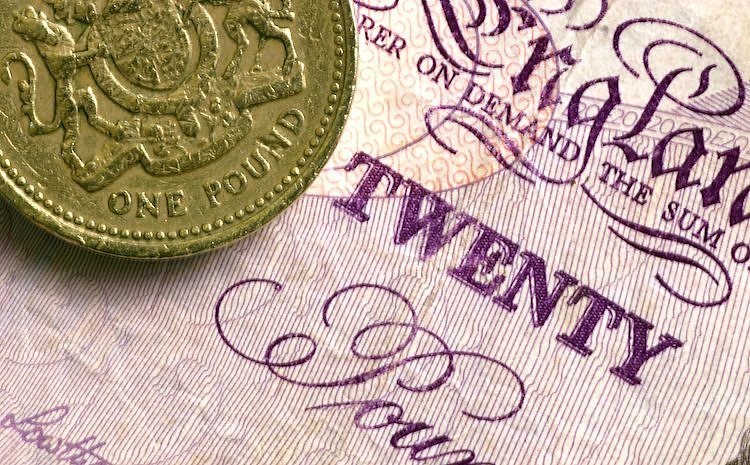- Pound Sterling has found support below the crucial support of 1.2800 ahead of the anticipated speech from Andrew Bailey.
- United Kingdom’s economic outlook is under threat as investors expect a higher interest rate peak.
- In addition to Bailey’s speech, UK’s labor market data on Tuesday will be keenly watched.
The Pound Sterling (GBP) has delivered a recovery move as market participants ahead of a speech from Bank of England (BoE) Governor Andrew Bailey on Monday at 15:00 GMT. Earlier, the bias for the GBP/USD pair softened as investors are anxious due to expectations of more interest rate hikes from the BoE.
The economic outlook of the United Kingdom is under threat as households are already facing the burden of elevated interest payment obligations and further policy tightening would make domestic activities more vulnerable. In addition to Bailey’s speech, Britain’s Employment data will also be on investors’ radar. Clarity about labor market conditions would also provide cues about interest rate guidance.
Daily Digest Market Movers: Pound Sterling discovers strength ahead of Bailey’s speech
- Pound Sterling has faced some pressure as investors have turned cautious ahead of a speech from Bank of England Governor Andrew Bailey.
- Investors will keenly watch cues about inflation and interest rate guidance and methods to which the central bank is looking beyond monetary tools.
- UK’s economy is facing the burden of high inflation as the housing sector fell in June at the sharpest pace in more than 14 years due to higher borrowing costs.
- Britain’s inflation has remained elevated due to higher food inflation and labor shortages.
- Labor shortages are expected to increase further as almost one in three female workers is considering early retirement because of health issues.
- Investors would get clarity about labor market conditions after the publication of the United Kingdom Employment data, which will be released on Tuesday at 6:00 GMT.
- Claimant Count Change is expected to show an increase of 20.5K in June vs. a decline of 13.6K reported last month.
- The Unemployment Rate is seen unchanged at 3.8% and Three-month Average Earnings Index is expected to increase to 6.8% against the former release of 6.5%.
- Higher wage pressure is going to make Andrew Bailey uncomfortable. The Bank of England Governor is putting blood and sweat to bring down inflation. This is a big challenge for UK PM Rishi Sunak who promised to halve price pressures by year-end.
- Last week, Andrew Bailey urged industry regulators to stop overcharging customers for fuel.
- Negative market sentiment is gaining strength as the US Dollar Index (DXY) has rebounded as hopes for more interest rate hikes from the Federal Reserve (Fed) have elevated.
- United States Nonfarm Payrolls (NFP) missed expectations but wage pressures remained resilient, which is sufficient to terrify Fed policymakers about inflation guidance.
- An interest rate hike announcement from Fed Chair Jerome Powell is well on track as higher Average Hourly Earnings could keep inflation extremely stubborn.
- Chicago Fed President Austan Goolsbee said two more interest rate hikes this year are well-favored.
- Going forward, investors will keep their entire focus on the US Consumer Price Index data, which is scheduled for Wednesday at 12:30 GMT.
Technical Analysis: Pound Sterling recovers from below 1.2800
Pound Sterling has shown a corrective move on Monday after registering a fresh annual high at 1.2850. The Cable is approaching the upper portion of the Rising Channel chart pattern formed on a daily period. Short-to-long-term daily Exponential Moving Averages (EMAs) are sloping north, portraying sheer strength in the Pound Sterling.
Momentum oscillators are oscillating in the bullish range indicating strength in the upside bias.
A fresh upside would take place if the Pound Sterling will push the Cable above the annual high of 1.2850. The upside bias could fade if the asset drops below the crucial support of 1.2680.
BoE FAQs
The Bank of England (BoE) decides monetary policy for the United Kingdom. Its primary goal is to achieve ‘price stability’, or a steady inflation rate of 2%. Its tool for achieving this is via the adjustment of base lending rates. The BoE sets the rate at which it lends to commercial banks and banks lend to each other, determining the level of interest rates in the economy overall. This also impacts the value of the Pound Sterling (GBP).
When inflation is above the Bank of England’s target it responds by raising interest rates, making it more expensive for people and businesses to access credit. This is positive for the Pound Sterling because higher interest rates make the UK a more attractive place for global investors to park their money. When inflation falls below target, it is a sign economic growth is slowing, and the BoE will consider lowering interest rates to cheapen credit in the hope businesses will borrow to invest in growth-generating projects – a negative for the Pound Sterling.
In extreme situations, the Bank of England can enact a policy called Quantitative Easing (QE). QE is the process by which the BoE substantially increases the flow of credit in a stuck financial system. QE is a last resort policy when lowering interest rates will not achieve the necessary result. The process of QE involves the BoE printing money to buy assets – usually government or AAA-rated corporate bonds – from banks and other financial institutions. QE usually results in a weaker Pound Sterling.
Quantitative tightening (QT) is the reverse of QE, enacted when the economy is strengthening and inflation starts rising. Whilst in QE the Bank of England (BoE) purchases government and corporate bonds from financial institutions to encourage them to lend; in QT, the BoE stops buying more bonds, and stops reinvesting the principal maturing on the bonds it already holds. It is usually positive for the Pound Sterling.
